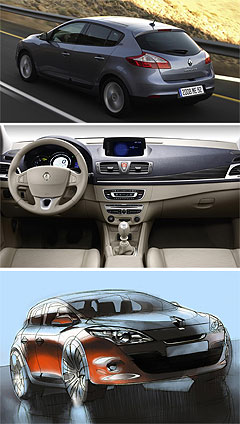First look: Megane MkIII - no butts about it
BY BYRON MATHIOUDAKIS | 11th Sep 2008

European sales commence in November, with an Australian launch of a variation of this car scheduled to take place late next year or early in 2010.
A speedy arrival is part of Renault’s fast-track new-release regime that has already seen the imminent addition of the (related) X-Trail-based Koleos compact SUV to Australia, just months after its Continental debut.
The latest Megane’s overall length and wheelbase grow, to 4.3 metres and 2.64 metres respectively, with a wider track (now 1550mm) also incorporated. Yet weight actually falls slightly, by 8kg.
Gone is the current, second-generation model’s opinion-splitting derriere, which formed a bold two-and-a-half-box silhouette to set the Renault hatch apart from its small-car competition and keep the seven-year-old design relatively fresh.
This time, Renault has emulated the larger, latest Laguna’s look, with a two-box hatch shape utilising short front and rear overhangs. Smooth taut surfacing and a grille-less nose are standout items amidst a contemporary but conservative visage.

A sedan, wagon, convertible and two Scenic people-mover offshoots are also in the pipeline as part of a six-model Megane III strategy, and all are sequenced to surface within the next 18 months as part of a $A3.95 billion investment program in Renault's new small-car range.
According to Renault, its design and engineering teams spent two years "...focused on three main areas of development, namely reinforcing the personality of each member of the Megane line-up, ensuring a balanced offer in terms of performance and equipment, and targeting best-in-class positioning for all key features.” Huge strides in quality, fit and finish, reliability and durability are promised, manifested in the Megane III’s tight shutlines, premium feel, expensive-looking trim, and a host of tasteful stylistic flourishes.
These include a simple yet elegant LED speedometer set amongst a nicely presented binnacle, an expansive dashboard featuring plenty of symmetry, and the use of contrasting colours throughout the cabin.
New to the range are features such as hands-free entry and ignition, an ‘adaptive’ audio system that alters its sound according to the number and position of the car’s occupants, improved satellite-navigation and Bluetooth systems, tyre pressure monitors and an ‘overspeed’ device that lights the dash up in red if exceeded.
Underneath, the new car is essentially a re-engineered version of the current X84 model, featuring MacPherson strut front suspension, a torsion beam rear-end, electro-mechanical power steering and – of course – front-wheel drive.
There has been evolution, rather than evolution, in the new Renault’s engine room too.
An armada of dCi common-rail turbo-diesel engines are going to be rolled out, known as the 85 (62kW), 90 (66kW), 105 (77kW), 110 (81kW), 130 (95kW), 150 (110kW) and 160 (117kW) units, according to each one’s brake horsepower rating, and depending on the region and/or gearbox choice.
All dCi units for now are likely to be based on Renault’s new-generation 1.5-litre four-cylinder family, with every one up to and including the 110 emitting less than 120 grams of carbon dioxide pollution per kilometre, while the larger ones are rated at a competitive 135g/km.
Petrol-powered versions kick off with 74kW and 81kW 1.6-litre, and 103kW 2.0-litre multi-valve four-cylinder engines, with the latter also available in 132kW turbocharged guise.
Some markets may receive Renault’s new 96kW 1.4-litre turbocharged petrol powerplant that is claimed to have the output of a 1.8 and the torque of a 2.0-litre (190Nm), but with a CO2 rating of a 1.6.
Transmission choices are likely to comprise five and six-speed manuals depending on engine choice, with some also available with a four or six-speed automatic, as well as a sequential manual gearbox.
Renault says that some of its new Megane models will be able to run on bio-fuels (bio-ethanol or bio-diesel), although this depends on the country in question.
Fuel consumption is said to be down on all models, thanks to greater engine efficiencies, improved aerodynamics and a concerted weight-reduction drive that has yielded results despite the Megane III’s greater overall sizing.
On the environmental front, 95 per cent of the new car is recoverable (by weight), with 12 per cent of its plastics sourced from recycling.
Also following the outgoing small car is a big commitment to safety, with the Megane III boasting new-generation double side impact sensors and dual-chamber airbags for reduced side-on collision trauma, anti-lock brakes with electronic brake-force distribution and brake assist, traction/stability and new ‘understeer’ controls and anti-whiplash head restraints.
Now in its third-generation iteration since the series debuted in Europe in 1995 (and 2001 in Australia as the X64 Convertible), the Megane is the vital missing link in resurrecting both Renault’s sagging European sales, as well as reviving the French company’s moribund local fortunes.
However, as GoAuto reported last month, we will see a slightly different model to the Megane III shown here.
Although it should look, feel and drive just like the latest European version, ‘our’ Megane will be a new ‘International’ version that will probably be sourced outside of Western Europe.
A key element of this car will be its Nissan-sourced engineering changes to help keep prices down, as well as the deletion of some of the aforementioned new technologies.
The ‘European’ Megane III will debut at the Paris motor show on October 2.
Read more:
Geneva show: New extreme for Renault Megane‘Nissan’ Megane emerging